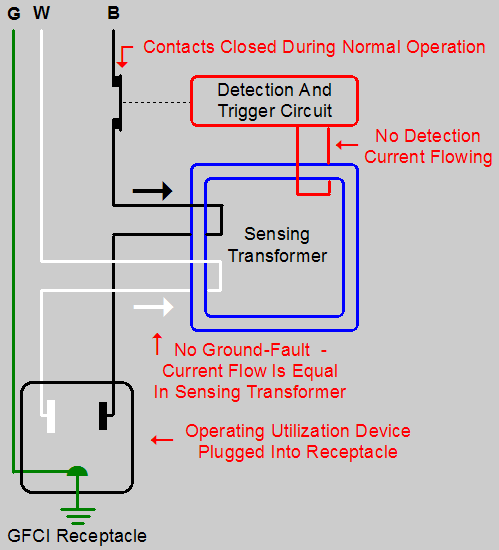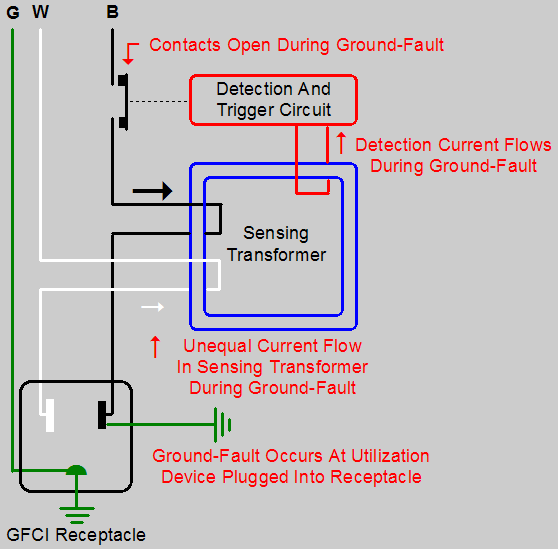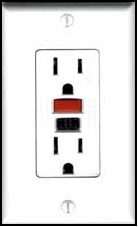

CODE UPDATE

Update #16 Ground-Fault Circuit Interrupter Protection (NEC 620.85)
Ground-fault circuit interrupter protection for personnel is required in several elevator equipment locations. A ground-fault is a low-level short circuit that does not draw enough current to open the overcurrent protective device but is strong enough to cause bodily injury or death. Ground-faults can be caused by dirty, failed, or wet insulation.
The type of ground-fault circuit interrupters (GFCI) that are required for personnel protection are called Class A. These GFCI's are designed to trip when the current to ground is in the range of 4 through 6 milliamperes.
The National Electrical Code (2005 edition and earlier) requires the following:
620.85 Ground-Fault Circuit Interrupter Protection for Personnel.
Each 125-volt, single-phase, 15- and 20-ampere receptacle installed in pits, in hoistways, on elevator car tops, and in escalator and moving walk wellways shall be of the ground-fault circuit interrupter type.
All 125-volt, single-phase, 15- and 20-ampere receptacles installed in machine rooms and machinery spaces shall have ground-fault circuit interrupter protection for personnel.
A single receptacle supplying a permanently installed sump pump shall not require ground-fault circuit interrupter protection.
Remember...a single receptacle will permit the operation of only one utilization device. In this case the device would be the sump pump and nothing else. A duplex receptacle is not acceptable. Many sump pumps "produce" a certain amount of low-level short circuit current while operating normally and would be constantly opening the ground-fault circuit interrupter. Remember, the pump is required to operate in and under water. This short circuit current would cause the pump to stop operating and no one would know about it until the pit was inspected for that "foul odor" caused by the standing water.
In the following two images I attempt to describe the operation of a ground-fault circuit interrupter installed in a receptacle.
The legend for the 125-volt single phase receptacle wiring is:
G - This is the equipment grounding conductor ("ground wire") and it is typically bare or has green or green with one or more stripes on its covering or insulation. (See 250.119 NEC-2005)
W - This is the grounded conductor ("neutral wire") and it typically has white or gray insulation. (See 200.6 NEC-2005)
B - This is the ungrounded conductor ("hot wire") and it typically has black insulation or some other color that is not white, gray, or green. (See 210.5(C) NEC-2005)
In the first image a properly operating utilization device (drill motor, reciprocating saw, or other load) is plugged into the receptacle. (The utilization device in both images has been omitted for clarity.) In a normally operating circuit the current flowing into the sensing transformer in the ungrounded conductor (B) is equal to the current flowing into the sensing transformer in the grounded conductor (W). Under these conditions the detection and trigger device will sense equal current flow and the contacts remain in the closed position. In other words, if the current flowing in both the B and W conductors is equal the sensing transformer will not generate any current flow in the detection and trigger conductor coil and the receptacle will continue to supply power to our utilization device.

GFCI During Normal Operation - Utilization Device Plugged Into Receptacle
In the second image an improperly operating utilization device is plugged into the receptacle. Because unequal current is flowing in the B and W conductors, due to the ground-fault, a current is induced in the sensing transformer. The detection and trigger device is called into action by the current flow in its coil on the sensing transformer. The contacts which are in series with the ungrounded conductor (B) open and the current flow through the utilization device and the ground-fault is interrupted.

GFCI During Ground-Fault Operation - Utilization Device Plugged Into Receptacle
You may have noticed a slight difference in the description of the receptacle types in the electrical code requirement at the top of this update (NEC 620.85). Some receptacles require resetting at the device itself. These are the receptacles described as "the ground-fault circuit interrupter type." We would find these receptacles "in pits, in hoistways, on elevator car tops, and in escalator and moving walk wellways." I believe the reasoning behind this arrangement is to insure that a person working in these somewhat confined spaces can readily reset a tripped GFCI receptacle.

GFCI-Type Receptacle - "RESET" at Receptacle
Other receptacles may be controlled by a ground-fault circuit interrupter circuit breaker installed at the distribution panelboard or by a single ground-fault circuit interrupter receptacle that controls other standard receptacles downstream. These are the receptacles described as requiring "ground-fault circuit interrupter protection." We would find these types of protected receptacles "in machine rooms and machinery spaces", however, resettable GFCI receptacles are almost always used in these spaces.

GFCI-Type Circuit Breaker - "RESET" at Distribution Panel
Many ground-fault circuit interrupters can detect a grounded neutral condition as well. In this case, the GFCI will trip as soon as power is applied even if a utilization device is not connected to the protected receptacle. Some manufacturers ship their GFCI receptacles in the tripped condition. If the device is not installed properly it cannot be reset.
Incidentally, it is permissible to check the operation of these receptacles by utilizing the "TEST" and "RESET" buttons. I have read that GFCI devices fail at an alarming rate. It is recommended that they be tested on a regular basis. Remember, it only takes a small amount of current to adversely affect the rhythm of the human heart...don't let it be your heart!
More information on GFCI's and many other devices, equipment, and construction material may be found in the UL Whitebook - General Information for Electrical Equipment Directory 2005.
![]()
![]()
![]()
 E-mail Bob Desnoyers with your GFCI comments
E-mail Bob Desnoyers with your GFCI comments 
Welcome/Contact ![]() Résumé
Résumé ![]() Elevator Utilities
Elevator Utilities ![]() Hydraulic Utilities
Hydraulic Utilities
Electric Utilities ![]() Odds & Ends
Odds & Ends ![]() Code Updates
Code Updates ![]() Testimonials
Testimonials
